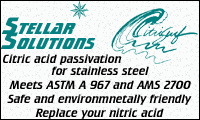
Curated with aloha by
Ted Mooney, P.E. RET

The authoritative public forum
for Metal Finishing 1989-2025

-----
Case depth in carburizing or nitriding
Q. Can you please inform me where can I find national or international standards online that talk about case depth in nitriding or carburizing?
George Bougioutakis- Leeds, UK
2002
A. Here are some American standards of possible relevance. Links to ISO, British and MIL-S-12515C SURFACE HARDENING: FLAME AND INDUCTION (FOR FERROUS ALLOYS) [inactive]
MIL-STD-1878A CARBURIZING, GASEOUS ATMOSPHERE, PROCESS FOR [Canceled]
SAE-AMS2759/7
CARBURIZING AND HEAT TREATMENT OF CARBURIZING GRADE STEEL PARTS
ASTM A534 Standard Specification for Carburizing Steels for Anti-Friction Bearings
ASTM A255 Standard Test Method for Determining Hardenability of Steel
ASTM E1077
[withdrawn] Standard Test Methods for Estimating the Depth of Decarburization of Steel Specimens
ASTM G79
[withdrawn]
Standard Practice for Evaluation of Metals Exposed to Carburization Environments
ASTM A37 Recommended Practice for Carburizing and Heat-Treatment of Carburized Objects -withdrawn 1936
ASTM A355 Standard Specification for Steel Bars, Alloys, for Nitriding
Search ISO specifications at http://www.iso.ch/iso/en/ISOOnline.frontpage
British Standards (BS) at http://bsonline.techindex.co.uk
British DEF, DTD, NES standards at http://www.dstan.mod.uk/ and DIN standards at http://www2.din.de/?lang=en
I am not sure exactly what you are seeking. Case [depth] is typically considered as the portion of a ferrous alloy, extending inward from the surface, in which the hardness is greater than that of the core.* However, it is common to specify a minimum hardness at a given depth, and this can be achieved by various combinations of temperature, time, surface carbon activity, and initial alloy composition. Carburizing and nitriding occur by non-steady-state diffusion described by Fick's second law, with a concentration curve that decays from the surface into the bulk [Mathematical solution requires diffusion coefficients and the erf function, and is covered in metallurgy/ materials science courses]. To avoid extreme brittleness, an upper limit is sometimes placed upon the surface hardness.
*ASM Handbook, Volume 5, Surface Engineering, p. 948 (1994).
- Goleta, California
Rest in peace, Ken. Thank you for your hard work which the finishing world, and we at finishing.com, continue to benefit from.
Replacement for MIL-STD-1878
Q. Hi all,
I have 2 questions:
1) Which standard replaces the MIL-STD-1878?
2) Can I use this standard for SAE 4340 steel?
Regards,
Tomer.
- Israel
January 9, 2020
A. Tomer,
According to
https://quicksearch.dla.mil/qsDocDetails.aspx?ident_number=37183
there was no replacement named at the time the standard was cancelled. Though Ken Vlach's reply above suggests some alternatives.

Ray Kremer
Stellar Solutions, Inc.
McHenry, Illinois

Q, A, or Comment on THIS thread -or- Start a NEW Thread